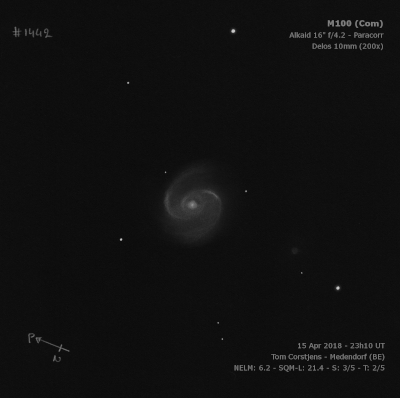
Pierre Méchain discovered M100 = NGC 4321 = h1211, along with M98 and M99, on 15 Mar 1781 and Messier verified it a month later. William Herschel described "a vL nebula of about 10' in diameter, with a small bright cluster of supposed stars in the middle. It is followed at the distance of 6 or 8' by another distinct F, S, R, r nebula [NGC 4328] which is nearly in the same parallel with the great one." His description obviously refers to the sharply concentrated core, though he gave this as an example in his 1814 publication of a nebula probably consisting of a cluster of stars.
Lord Rosse discovered spiral structure in M100 on 9 Mar 1850 (or earlier) and included M100 in his list of "Spiral or curvilinear" nebulae in the 1850 PT paper. William Lassell published two sketches of M100 using his 48-inch on Malta on 24 and 26 Apr 1862. The second one is an excellent rendering of the spiral arms, which both wrap about 1 1/2 revolutions around the core. Dreyer's comment "(L): 2-branched spiral", is based on this sketch.
M101 is one of the largest and brightest spirals in the Virgo cluster. It was the fist Virgo cluster member that the HST observed Cepheid variables (1993) and derived a distance of 55 million light years (since revised to ~50 million light years). Five supernovae have been recorded: 1901B, 1914A, 1959E, 1979C, 2006X. The first two were found on archived plates and announced by Heber Curtis in Lick Observatory Bulletin 300 (1917LicOB...9..108C). SN 1901B was found on a photograph taken on 17 Mar 1901 and SN 1914A was found on a photograph taken 2 Mar 1914.
400/500mm - 17.5" (5/23/87): bright, very large, almost round, well-defined bright core surrounded by a large, fainter halo. Two faint galaxies NGC 4323 and NGC 4328 lie 5' N and 6' E, respectively. This is the brightest spiral in the Coma-Virgo cluster.
900/1200mm - 48" (4/18/15): stunning view of this gorgeous spiral at 375x and 488x. M100 was sharply concentrated with an intensely bright circular nucleus. Two prominent, high contrast arms (fairly narrow) each rotated ~270° and could be clearly traced to within 1' of the center. The south and north outer tips of the arms are between 5.5'-6' apart with the overall size ~6'x5'.
One arm begins off the WNW side of the core with a bright mottled section angling nearly north-south for ~25". This section contains multiple HII sites NGC 4321:[HK83]220/223/229/230 from Hodge and Kennicutt's 1983 "An Atlas of H II regions in 125 galaxies". The arm curls clockwise around the south side. A small (~8" dia.) HII knot (#160/171/172) is within this arm, 1.0' S of center. Just to the east [1.5' SE of center] is a brighter, mottled section that contains a close pair [18" separation] of compact HII knots (#110 and #69/87). The surface brightness of the arm abruptly drops as it shoots due north on the east side of the halo for ~3'. The arm dims further as it curves west on the northeast side of the outer halo and ends just southeast of mag 15 star situated 2.9' NNW of center.
The second arm begins ~1' SE of center as a thicker, much brighter region. The Hodge-Kennicutt Atlas catalogues numerous HII designations in this region, but none stood out individually. The arm sharply narrows and rotates clockwise around the north side of the core towards the west. It passes just south of two mag 15.5 stars, where there is a slightly brighter mottled section containing HII regions #252/253. The arm dims significantly as it heads south on the west side of the halo. Finally, it weakens further and spreads out at the end on the southwest side of the galaxy [2.6' from center].
Notes by Steve Gottlieb